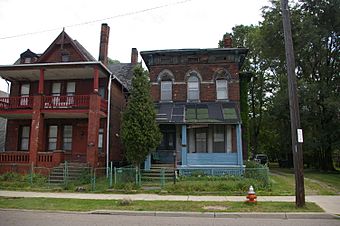Andrew and James Dall Houses facts for kids
Quick facts for kids |
|
|
Andrew Dall Jr. and James Dall Houses
|
|

Front of the houses: James' to the left, and Andrew's to the right
|
|
| Location | 2225 and 2229 E. 46th St., Cleveland, Ohio |
|---|---|
| Area | Less than 1 acre (0.40 ha) |
| Built | 1875 |
| Architect | Andrew Dall Jr. |
| Architectural style | Stick/Eastlake, Italianate |
| NRHP reference No. | 84002913 |
| Added to NRHP | July 19, 1984 |
The Andrew and James Dall Houses are two old and important homes in Cleveland, Ohio, United States. They were built a long time ago, in the late 1800s. These houses belonged to two of Cleveland's most important builders. Today, they are recognized as a special historic site.
Contents
Who Were the Dall Brothers?
Andrew Dall, Sr., came to the United States from Scotland in 1852 with his family. Two of his sons, James and Andrew Jr., became very successful builders in Cleveland. They started by building things and managing projects. Later, they also became skilled craftsmen who worked with stone.
Building Their Own Homes
The Dall brothers decided to build their own houses in the 1870s. Andrew Jr.'s house was started in 1875 and finished two years later. James' house took a bit longer, from 1878 to 1881.
While their own homes were being built, the Dalls worked on many other famous projects in Cleveland. Some of these included Adelbert Hall and St. Paul's Episcopal Church. They also built many grand homes on Euclid Avenue, which was known as "Millionaires' Row."
What Do the Houses Look Like?
The two houses are next to each other. They are made of brick and have strong sandstone foundations. Andrew's house is built in the Italianate style. This style often features tall windows and decorative eaves. James' house shows parts of the Eastlake style, which is a type of Queen Anne style. This style often has detailed wooden decorations.
Next to the houses, there is an old cobblestone driveway. This driveway was once used for horse-drawn carriages.
Why Are These Houses Historic?
In 1984, both houses were officially added to the National Register of Historic Places. This is a list of places in the United States that are important to history. Many other houses in Cleveland from that time were added to the list because of their unique architecture. However, the Dall houses were special for a different reason. They were recognized because they were the homes of Andrew and James Dall. These brothers were some of the most important builders in Cleveland's history.




